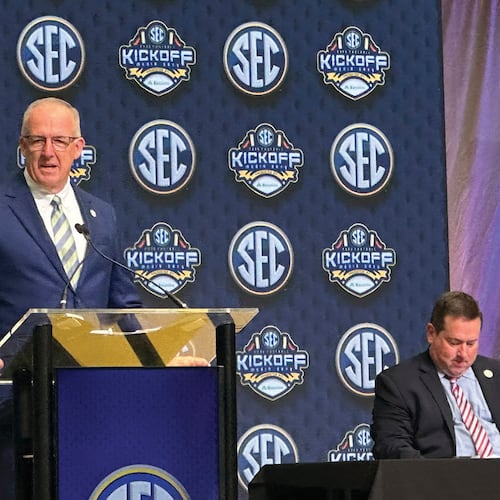ATHENS – Georgia hasn’t had a 1,000-yard rusher since D’Andre Swift capped off a streak of six straight seasons with 1,218 yards in 2019. Based on early results, the Bulldogs aren’t going to have one this year either.
Does that mean RBU is about to be a thing of the past? Not necessarily, the Bulldogs say.
While there is a definite emphasis on the passing game through two games in 2022, that doesn’t mean that’s the way Georgia is going to play all season. And, beyond that, backs are still integrally involved in the Bulldogs throwing the football. Senior running back Kenny McIntosh is, after all, the team leader in receiving yards (178), all-purpose yards (211) and touchdowns (2).
That said, Georgia simply isn’t running the ball with the authority it has been known for over the years. At no time was that more evident than this past Saturday.
Facing an FCS team in Samford -- whose defensive line averaged 262 pounds -- the much larger Bulldogs averaged only 4.0 yards per carry. Last year, even with quarterback sacks factored in, Georgia averaged 5.2 yards a carry for the entire season. It’s averaging 4.5 so far this year.
Heading into Week 3 of this season, Georgia sits at 10th in the SEC in rushing yards per game (129.5) and ninth in yards per carry. Traditionally, the Bulldogs are at or near the top of such lists.
“That’s not our standard,” senior offensive tackle Warren McClendon said before the Bulldogs practiced Monday. “You know, we have to go in today and look at the film and see what (Samford was) doing. They did a lot more moving than we expected. We’ve just got to go in and figure out the mistakes we made and perfect them this week.”
It would behoove the Bulldogs to get it straightened out quickly. They open SEC play at South Carolina this Saturday. Arkansas proved the way to beating the Gamecocks is by pounding them with a physical ground game. The Razorbacks rushed for 295 yards and scored five of their six touchdowns on the ground in a 44-30 win over South Carolina in Fayetteville this past Saturday.
Meanwhile, the Gamecocks’ defense came out beaten up. They lost two starters – defensive end Jordan Strachan and middle linebacker Mo Kaba – to ACL injuries in the game.
“I’m extremely disappointed and heartbroken for both of these young men,” South Carolina coach Shane Beamer said in a statement released by the school Monday. “They both worked really hard to prepare for this season and were off to great starts for us. Their best football is still in front of them.”
One would think recent developments lend itself to a Georgia game plan that might emphasize pounding the football between the tackles against the Gamecocks. Not necessarily, Georgia coach Kirby Smart says.
The Bulldogs are clearly emphasizing opening up the offense in Year 3 under offensive coordinator Todd Monken and quarterback Stetson Bennett. Through two games, 75.3% of Georgia’s 1,050 yards offense has been generated through passing.
Junior running back Kendall Milton has been Georgia’s leading rusher in the first two contests. With 85 yards on 10 carries Saturday, he has 135 yards through two games with a 7.5 yards per carry average.
Immaterial, Smart says. With the No. 1-ranked Bulldogs operating its purest form of run-pass option (RPO) offense yet, people might need to place some of Georgia’s passing yards in the run column. Georgia’s coaches are, he insists.
“I think people look at statistics and that’s all they look at. I look at it as, what do we ask our guys to do?” Smart said. “A lot of times, no offense, you guys don’t understand about football. When you talk about passing and yardage, I would say 30 or 40 percent of the plays you call passing yardage is a run play, and they could be very successful run plays. The question is, are they more successful as a run play or are they more successful when we decide to throw the ball out of that run play? So, the evaluation for us is those plays are running plays.”
Actually, it’s really not that complicated. Either you hand off or lateral the ball to offensive players or you don’t. With the sure-handed senior McIntosh serving as Georgia’s primary back, the Bulldogs often are dumping the ball off to him through a series of quick-screens, swing passes and hitches. It has proven quite effective as McIntosh leads the Bulldogs with 14 receptions for 178 yards, or an average of 12.7 yards per catch. Milton (12.5) and Daijun Edwards (15.3) are sporting similar per-catch averages.
That has reduced the number of play-action “shot plays” the Bulldogs have been able to attempt. Thus, Georgia technically has been less explosive on offense.
The upside is, Bennett has been less vulnerable to pressure and Georgia’s overall offense has been less predictable.
According to Pro Football Focus, Bennett is averaging 13.9 yards per pass attempt with an average depth of target of just 2.9 yards. Hence, Georgia’s quarterback enters the South Carolina game with a whopping completion percentage of 75.4.
Those are all numbers the Bulldogs are thrilled with and certainly could live with all season.
“It’s probably dictated more by what the defense does and what the defense gives us,” Smart said of the RPO concept. “You know, I would like to think we could sustain it when it comes to accuracy, completion percentage, decision-making. A lot of those plays, there’s multiple people that the ball can be thrown to. It boils down to, did we read the coverage right?”
Bennett gets high marks in that regard. That said, there remains those situations with everybody in the stadium knows you’re going to run the football based on down, distance and time on the clock.
Georgia found itself in such situations several times against Samford this past Saturday. The Bulldogs were 5-for-13 on third-down conversions, 3-for-8 on TD-scoring opportunities in the redzone and had to settle for four field goals. And that was in a home game against an FCS opponent, not a road game against an SEC rival such as Georgia will encounter at Williams-Brice Stadium this Saturday.
“We left some things out there, for sure,” sophomore center Sedrick Van Pran said. “But can be better and we will be better and that’s something I’m excited about going into this week of practice.”
Georgia’s redzone numbers, impeccable in a 49-3 win over Oregon, took a hit against Samford, of all opponents. The Bulldogs can expect the going to be even tougher in Columbia, regardless of South Carolina’s defensive health.
Smart says Georgia will be ready.
“I think you’ve got to have a run game to win tight ballgames, to be a good physical team,” Smart said. “But there’s not a lack of confidence in our run game for me.”
About the Author
Keep Reading
The Latest
Featured


